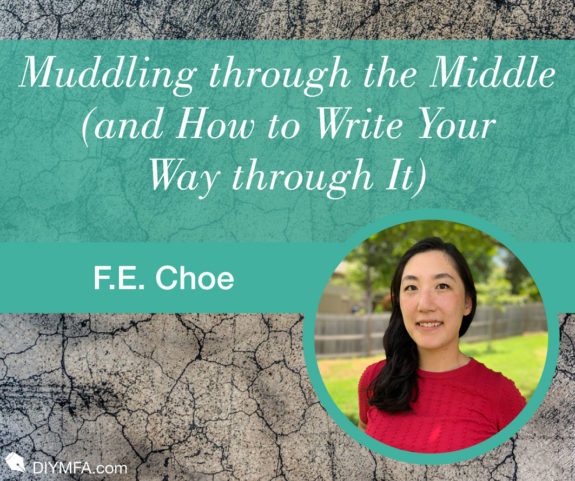Ah, mid-November! When, in many parts of the US, one delights in autumnal hues, crisp, sweet, final apple harvest days, and pumpkin-spiced everything as far as the eye can see!
Or, if you are participating in National Novel Writing Month, this might be the crankiest time of year. “50,000 words in 30 days? What on earth was I thinking?” you mutter before setting fire to your meticulously, color-coded outline from October.
Have you recently hit a wall in the middle of a project? Do you feel unable to move the story forward and escalate events in a meaningful way? Have you lost the thread, and with it, the heart and feeling, the excitement and urgency that drove you to start the cursed thing in the first place?
Whether or not you are participating in NaNoWriMo, if you answered “yes” and are currently struggling with a mushy middle, here are some practical exercises to help you write your way through it.
Briefly re-read your current draft.
Set a timer if you have to. Look for clues about the stakes, your characters’ known as well as unacknowledged goals and motives, the primary conflict, and the heart of your story. Do not get bogged down by line edits here. Do remain open to the possibility that the story that existed in your mind during the outlining or early drafting stage might not actually be the story you end up telling.
The key here is to read without preconceptions of what your story “should” be, but rather with an eye for the key elements, symbols, and potential themes currently seeded in your work and calling out to be developed further. Also ask yourself the following questions. Have I written myself into a corner anywhere? What expectations have I set up for how the rest of the story is going to unfold? How will fulfilling or subverting these expectations shape the ending for a reader?
Write a 2-5 sentence synopsis.
Short, sweet, and nearly foolproof, this is my personal go-to tool for muddy middles. This synopsis should include what happens. For example, Pat and Leslie adopt a dog, Rufus. One night, Rufus escapes from the backyard. Pat and Leslie search for Rufus unsuccessfully. Shortly after, they break up.
It should also hint at, if not capture, the underlying truth of the story. Taking that example further, Pat and Leslie’s different approaches to searching for the dog stir up old arguments and provoke them to question their relationship, the nature of commitment, loyalty, love, and ownership.
A somewhat silly example, but you get the idea. The point of this exercise, like the first one, is to help clarify what the piece is saying on a deeper level. Use this information to flesh out the middle of your story. What can you do in your scenes and how can you arrange them to better illustrate and illuminate this larger truth?
Check technical aspects of your story like POV, verb tense, and your choice of MC.
To be clear, I am not here to dictate exactly how you should write your next magnum opus. If you are really struggling with your manuscript though, it is worth your time to consider the technical aspects of your story and rule out the possibility that a larger story problem is disguising itself as a block in the middle.
Did you intentionally choose the current point of view for your story? Does the current POV work well? What does it add to the story? Why did you choose to write the story in its current tense? How might playing with tense change the story?
And while you consider how your choices as a writer shape your story, spend some time reflecting on your main character. How does your protagonist (who may or may not be the same as the narrator) and their transformation or potential for change relate to the events of your story? To refer back to my previous example, the story we end up with might change drastically depending on whether the main character is Pat, Leslie, a neighbor, or the dog.
Go off-stage and off-script for a bit.
For me, muddling through the middle often involves picking up a draft from my last session and being disappointed by writing that feels stale, unexciting. And if a scene is boring me to death as I write, why should I expect a reader to give me more of their time and grace as they read?
If you find yourself in a similar situation, save your current manuscript, and open up a separate, blank document. Use the blank page for pure exploration, the wilder the better. Exhaust clichés and save your characters from peril at the very last minute by way of deus ex machina. Kill a key character. Introduce their evil doppelgänger from a separate timeline. Have an extraterrestrial zombie beast arrive unannounced on their doorstep.
Not every scene you write will end up in your final manuscript. And sometimes it is precisely those offstage moments of exploration that give us the kind of insight into our characters that allows us to render them with the very complexity demanded by a publishable, final draft.
Don’t be afraid to skip around either. If you just can’t wait to write the climax, then don’t! Go ahead and write that scene or chapter where the stakes could not possibly be any higher, then use it to reverse engineer the middle and beginning of your plot. If working backwards is what motivates you to finish your draft, by all means go for it.
And if, after all that, you are still stuck?
It has happened to even the most seasoned and successful writers. What do you do when no amount of wordsmithing and hair-pulling seems to work?
It could be that the material is incredibly personal or emotionally taxing. It could be that a writer has not quite developed all the skills or sleight of hand required of a certain story. Albeit rare, there are times when a little time and distance are just the thing a piece needs. In that case, it is okay to set that particular story aside and work on another project before revisiting it.
Now, the briefest of assignments. Because NaNoWriMo or not, you have writing to get back to.
Write the 2-5 sentence synopsis of a manuscript you have been struggling with. Be sure to answer both questions in your synopsis. 1. What happens? 2. What is the story saying on a deeper level? What meaning is being created for the reader by the sequence of events, actions, and reactions?

The elder daughter of Korean-Canadian and Austrian immigrants, F.E. Choe currently lives in Columbia, South Carolina. When she is not at her desk trying to craft true and beautiful sentences or piecing together her latest short story, you will find her feeding the dog scraps under the table, reading, or training her backyard flock of hens to walk backwards. Follow her on Instagram @f.e.choe.







